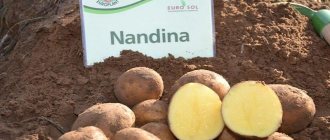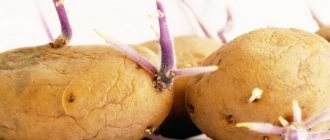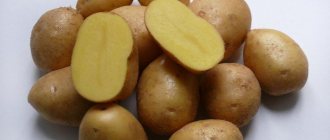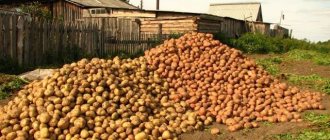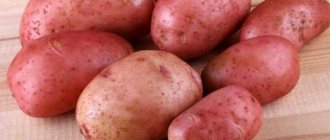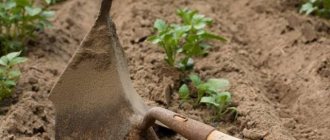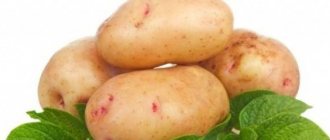Description and characteristics of potatoes
The Timo potato variety is known to many gardeners in regions belonging to the risky land ownership zone. Characterized by low and compact bushes with numerous leaves and light green stems. The leaves are large. The corollas of the flowers are bluish-violet.
At the ripening stage, the potato acquires a round shape, its color is light beige or yellowish. The potatoes have small eyes and the flesh is light yellow. The weight of one potato varies between 75-125 g. When digging early, gardeners harvest about 240 kilograms from one hundred square meters of land; with late harvesting, this figure increases by 80 kilograms.
The attractiveness of this variety is the ability to plant it in different regions of the country - Timo is universal. But when planting, they take into account the fact that weather and soil quality directly affect the yield. In the northern regions, there are 150-200 kilos of potatoes per one hundred square meters of area. In the northwestern regions the yield is up to 380 kilograms.
The early ripening variety attracts with tasty tubers. Potatoes are used to prepare various dishes. It can be baked, fried, boiled, or mashed.
Optimal growing conditions
Looseness throughout the growing season is one of the main indicators of soil suitability for potatoes Timo Hankkiyan. The soil should constantly allow air to pass through, and not float too much during rains, then the ripe fruit will be very tasty.
This plant can exist in a wide variety of climatic conditions and adapts to a variety of regimes: temperature, time and others.
And all Timo needs is minimal but proper care.
If the main part of the site is clogged with various annuals and biennials, then the use of herbicides is desirable, but the product must be allowed to be used before planting potatoes.
Proper care of Timo will pay off with a tasty and healthy harvest. Required:
- Loose soil is the best soil for Timo to grow, so the hilling process cannot be called useless. Good tuberization and low contamination of the soil by weeds is also achieved with good loosening of the soil.
- In dry weather, hilling can play a cruel joke on you and dry, hot air will dry out the soil, root system and fruits.
- During the development and growth of Timo potatoes, it is necessary to feed the plant. A wide variety of fertilizers are used: nitrogen - 60-80%, potash, which is worth paying attention to - 75-85% and phosphorus - 30%.
Note!
If you do not water the plants, the yield will decrease, and in the future the plant will die. The Timo variety is no exception to this rule. Particular attention should be paid to watering when the plant is blooming.
Potato tops that lie down and fly up are a sign that the harvest time has come. But it is customary to start the first digging only after one and a half months.
Tubers should remain consistent for a very long time if stored correctly. To make Timo potato fruits look presentable, you need to maintain the temperature regime and create air flows in the vegetable storage.
Advantages and disadvantages of "Timo"
Potatoes have not only positive but also negative sides, but there are many more advantages.
| Advantages | Flaws |
|
|
Advantages and disadvantages
Advantages of the variety:
- early ripening;
- resistance to drought and soil waterlogging;
- versatility of use;
- peel strength;
- formation of the crop before the massive spread of late blight;
- Possibility of growing in regions with cold climates.
Disadvantages of potatoes: Timo can be attributed to relative instability to the main pests of the crop, susceptibility to late blight of tops, average yield and low marketability of tubers due to non-compliance with agricultural technology, lack of nutrients and cultivation on dense and unstructured soils. Vegetable growers also note the instability of plants to sudden cold snaps and the frequent germination of tubers during long-term storage.
Requirements and preparation for landing
Timo potatoes are an unpretentious nightshade crop, notable for its undemanding soil composition. Responds well to regular feeding. It is better to plant potatoes in areas that have been previously fertilized with green manure - winter crops, annual herbaceous plants, and flax are used.
Potatoes are planted in mid-April under favorable weather conditions. In the northern regions, the landing period is postponed to the end of May. Be sure to loosen the soil, since the crop especially needs it.
Soil preparation
You need to start preparing the soil in the fall. Deep cultivation with fertilization is necessary. In autumn, as a rule, the soil is fertilized with manure or combined vitamin compounds.
A month before planting potatoes, deeply cultivate the soil again and add one portion of organic fertilizer. Make markings depending on the planting method. The planting method is selected based on the type of soil. There are three methods:
- Ridge planting. Designed for planting vegetables on heavy soil with excess moisture. Make ridges about 15 cm high and plant the tubers at a distance of about 30 cm from each other.
- Trench planting. This planting method is suitable for light sandy soils. Trenches are dug under the potatoes, 15 cm deep, at a distance of 70 cm from each other. It is advisable to place large tubers every 40 cm, small ones - every 30 cm.
- Smooth landing. The simplest option involves digging holes to a depth of half a shovel, the distance from each other should be at least 70 cm. Planting material is placed in the holes with the sprouts up and covered with earth.
Timo variety potatoes are often used for planting in non-standard conditions. A popular method is growing in containers. So from one bush you can get about 1 bag of potatoes. On less fertile soils, potatoes are grown using the mound method: a circular mound is made and several bushes are planted in a circle.
Seed preparation
Be sure to treat the seed before planting. After harvesting, the tubers are immediately separated for planting. They should be kept in a sunny room for several days to develop a green color. This technique will protect the tubers from mice. A month before planting, the tubers are removed from the cellar and disinfected.
Keep the tubers in a warm room for several weeks; after three weeks, sprouts should appear. At this stage, tubers are rejected: those that have not sprouted and those that have thin thread-like sprouts. Pre-soaking the planting material in a solution of nitrate and superphosphate, after which it is dusted with wood ash, helps to accelerate growth.
Landing
The crop is planted in the ground when the soil layer warms up to +8-10 degrees. Before this, the soil is plowed - it must be moist.
Place the tubers carefully so as not to damage the sprouts when filling the holes with soil. After 10-14 days, the plants should sprout. From now on, to increase yield and improve quality indicators, it is important to follow the rules of care.
Landing Features
Potato tubers of the Timo variety are easy to find at gardening fairs that take place in autumn and spring. When purchasing, you need to pay attention that the planting material is of high quality. The tubers are prepared in advance, about a couple of weeks before planting, but no later than the beginning of May:
- they are laid in rows and left in a sunny area to germinate;
- periodically spray the skin with water to activate the development of shoots;
- turn the tubers over for uniform germination.
At room temperature and sufficient lighting, potatoes germinate quickly and will be ready for planting in just 2 weeks. Then the sprouted tubers are treated against possible pests and planted in the ground. Timo grows well in any soil, but it is preferable to use porous soil based on black soil and sand. If the soil is clayey, then potatoes form more slowly, so it is better to dilute the clay with sand.
You will need little space for planting, since the bushes are compact. It is necessary to maintain a step of 20-30 cm between the holes, and it is enough to retreat 30-50 cm between the rows. There is no need to bury the tubers, otherwise they will take a long time to sprout. The optimal planting depth is 15-20 cm.
Tima's germination rate is good and fast. If the potatoes were planted on time, and the earth has already warmed up well, then the plants will appear in the second week.
Attention! Timo is often planted on an industrial scale due to the high yield of the variety, so planting in trenches can be used to save time.
Caring for Timo potatoes
Caring for Timo potatoes is not a difficult task, but it is of great importance, because the yield that will be obtained depends on this.
To care for potatoes, you should not only take care of watering the plants, but also not forget about weeding and hilling, applying fertilizers and preventive measures. This is the only way the harvest will please the gardener.
Watering
When there is no severe drought, it is enough to water the plants three times a season, preferably on time. It is not necessary to water the potatoes immediately after planting, because there is still spring moisture in the ground. During active growth of the tops, the potatoes are watered. During the flowering period, a second watering is carried out. The third time the potatoes are watered depending on the drying of the soil: when hardened and dry at a depth of 6 cm or more, it is moistened. A month before harvest, watering is stopped.
Watering also affects the production of large fruits - with a regular procedure, you will be able to get even fruits that attract good presentation.
Hilling and weeding
Hilling is a mandatory procedure that is carried out when planting material is planted to a depth of 5-10 cm. It is important to carry out earthing in severe drought and when planting potatoes using the ridge method.
As a standard, hilling is carried out three times. After strong sprouts of 10 cm appear, sprinkle them with 8 cm of soil. This method will protect the plants from frost. When the sprouts grow another 10 cm, they spud again. During the same period, the soil between the rows is loosened. The third time hilling is carried out a month before harvest.
Weeding is carried out regularly after watering and rains. This will prevent the formation of a hard crust on the soil surface. The higher the soil moisture level, the more it needs loosening.
Fertilizer
Regular, timely application of fertilizers is an important factor that affects productivity. The crop should be fertilized three times during the entire growth period:
- When the tops reach 10 cm. Feed the potatoes with organic fertilizers. One bush requires about 500 ml of liquid mullein. Fertilize after watering or precipitation.
- At the moment of budding. At this stage, ash or potassium compounds are added to speed up flowering.
- At the flowering stage. Organic fertilizers help accelerate the growth of the root system. To do this, 10 liters of water will require 200 ml of mullein and 40 g of superphosphates.
Disease and pest control
The Timo variety is characterized by increased resistance to many diseases. But many gardeners think differently. Some gardeners note that this variety is highly susceptible to wireworm attacks, and when re-grown it quickly becomes infected with late blight. Potatoes are not particularly resistant to the golden nematode.
There is no potato variety that does not suffer from being eaten by Colorado potato beetles. As a preventive measure against attacks by pests and fungal diseases, it is important to treat the tubers before planting. When re-planting potatoes during the season, the seed is additionally disinfected using the drug Fitosporin.
Main diseases and pests of the variety
The main disease to which the bush has low resistance is late blight of leaves. It appears in the form of brown spots on the leaves and can spread to tubers, so timely spraying of the bush with copper sulfate (10 g of product per 10 liters of water) is required.
Prevention consists of observing watering and fertilizing regimes, as well as timely destruction of weeds.
Find out more about how to deal with potato diseases.
Unfortunately, the resistance of any potato variety to pests is minimal, so only prevention in the form of treating planting material with special insecticidal preparations can save the crop.
Good results can be obtained from treating tubers with Prestige, Maxim, and Cruiser preparations, which can protect the crop from the Colorado potato beetle, wireworm, cicadas, aphids, thrips, moths, and flea beetles.
It is necessary to use the drugs in accordance with the instructions indicated on the packaging.
Harvest and storage
The harvest is harvested 50-70 days after planting. You can store tubers only in a room where it is dry and where the sun's rays do not penetrate. Good ventilation and an optimal temperature of +4-6 degrees are required.
Gardeners prefer storing tubers in specially prepared storage facilities, cellars or piles. When storing in a cellar, tubers should not be left on the ground. It is better to put them in nets or wooden boxes. For storage in piles, special depressions are made in the ground, filling them with tubers, covering them with straw, and burying them with earth - this helps preserve the crop for a long time.
Laura
Laura is a German variety of mid-early ripening. Tall, spreading bushes are distinguished by multi-colored petals: from white to light purple. The red peel effectively sets off the rich yellow color of the pulp, which is very tasty and aromatic. Up to 20 smooth, elongated oval tubers grow in one nest. The harvest is harvested no later than 80 days from the time of planting and is stored without loss for up to six months. Undermining can be done much earlier. Potatoes have good resistance to viral infections and diseases. Undemanding to weather conditions, but can hardly tolerate drought. The average yield of the variety is 300–400 c/ha.
Potato variety Laura
It is also worth noting such mid-late varieties as Chaika, Saturna, Valentina, Fakel, Skazka.
Another of the best representatives of late-ripening potato varieties is Zdabytok. Geographically, this potato variety grows in the central part of the country. The tubers have a distinct oblong shape, yellow skin, and light yellow flesh. This variety contains a large amount of starch, up to 25%. This group of late-ripening potato varieties also includes Belorussky, Vytok, Orbita, Temp, Lorkh, Olev. They are characterized by the following characteristics: round shape, average tuber size - 90–130 grams, white flesh that does not darken when cut, small eyes on the surface.
Variety of potato varieties
The cultivation of early potato varieties provides the population with this product already in the first half of summer. The tubers contain a large amount of vitamin C. These potatoes are recommended to be eaten with their skins on. Longer ripening varieties produce the majority of the potato harvest. These tubers contain a large amount of dry matter, protein and starch.
In order not to make a mistake when choosing a potato variety, it is necessary to study the soil and climatic conditions of the places for germination of the crop. There are varieties that grow well in sandy loam soils, while others only in fertilized, strong soils. The harvest will depend on the correct choice of variety. Early varieties are stored less well in winter; they are grown as a “delicacy” for the summer. For late varieties, it is necessary to prepare not only the soil, but also storage conditions. But with proper cultivation of late varieties and compliance with all agrotechnical requirements, you will get the highest yield with long-term storage.
| more about potatoes: | |
|
|
Comparison with other varieties
To compare Timo potatoes with other early and ultra-early varieties, the table shows the advantages and disadvantages, and the yield of the varieties.
| Variety | Ripening period | Advantages | Flaws | Productivity |
| Timo | 55-70 days |
|
| 240-380 kg/1 are |
| Bellarosa | 50-70 days |
|
| 300-400 kg/1 are |
| Vineta | 45-70 days |
| Low resistance to late blight. | 300-400 kg/1 are |
| Gala | 70-80 days |
| The variety is not resistant to late blight and is affected by rhizoctonia. | 250-400 kg/1 are |
| Impala | 50-60 days |
| Has a watery taste. Not resistant to late blight. | 200-380 kg/1 are |
| Colombo | 50-65 days |
| Low resistance to scab and late blight. | 220-420 kg/1 are |
| Riviera | 45-80 days |
| Low resistance to scab and late blight. | 300-400 kg/1 are |
Gardeners differ in their opinions regarding this variety. Some prefer it due to its good growth in drought. This variety is not afraid of excessive soil moisture and tolerates transportation well. Such qualities are especially important for vegetable growers who sell vegetables for profit. Other gardeners often complain that potatoes often suffer from late blight.
Timo potatoes are grown today by many farmers, as the variety is famous for its excellent taste, unpretentiousness and many advantages. It is preferred in the following years after the first trial. But to obtain high yields and large, high-quality fruits, potatoes should be properly planted and cared for.
0
0
Copy link
History of variety development
The Timo variety was bred in Finland, the originator is Boreal Plant Breeding LTD.
Considering that Finland is a northern country, the growing season of plants there is quite short, but warm and sunny summers make it possible to grow high-quality potatoes. So that potatoes have time to grow and ripen in a short period of time, breeders are actively creating ultra-early varieties, one of which is Timo. Thanks to its early ripening, the variety can be successfully grown throughout Central Russia.
Experts advise choosing the Northern, Central and Northwestern regions for cultivating Timo potatoes.
The Timo Hankkijan potato was bred by Finnish breeders.
Zoned for cultivation in the Northern, Northwestern and Central regions.
Plants in northern Finland have a very short growing season, so breeders constantly tried to develop their own variety, and they succeeded. Timo has been popular in the market for a long time. It grows very quickly, about a couple of months. The summer period there is characterized by transience, high temperatures and sunshine. The Finns coped with the creation of ultra-early potatoes with a bang, and now the world of agricultural technology has at its disposal a new variety - Timo Hankkijan.
As already mentioned, the variety has a large number of features:
- very early planting in spring;
- the fruit ripens in just 2-2.5 months;
- hybrid plant;
- is unpretentious;
- has good immunity to various diseases.
Note!
The potato looks like a very low, compact bush about 40 centimeters high.
The foliage is very lush, developed, with large leaves, the stems have a light green color characteristic of potatoes. Flowers of unusual color: purple or bluish. The root crop has a streamlined, rounded shape with medium-sized eyes, not set very deeply. The color of the skin varies from yellow to light beige, and in cross section it is close to a cream shade.
Characteristics:
- The variety does not have a high content of potato starch, only about 12-14%.
- The tuber weighs from 75 to 125 grams, which is equal to the average weight of the fruit.
The size of the root crop depends on the climatic qualities of the area where the plant grows and the frequency of watering. When served on a holiday table, it will delight you with its beautiful shape, because heat treatment does not remove its aesthetic qualities. It also keeps for a very long time. The average yield for the early variety is quite high: early digging results in approximately 230 c/ha, and late digging results in about 330 c/ha.
How to care
To obtain a large potato harvest and good plant development, it is necessary to provide care: timely water the crop, apply fertilizing, hill up the bushes, weed, prevent the development of diseases and pest attacks.
Watering and fertilizing
The crop is watered three times per season. Use 3 liters of water per bush. The water must be settled or drawn from a spring. The bushes are watered for the first time after the first shoots appear. The second time is when the plants begin to bloom, and the third time after the end of flowering. Watering is stopped 2 weeks before harvest.
Important! Tap water is not used for irrigation, as it contains chlorine, which has a detrimental effect on shrubs.
The first fertilizing is applied when planting the crop. The remaining fertilizing is combined with watering. The plant prefers mineral complexes containing nitrogen, potassium, phosphorus and manganese.
Organic fertilizers are also used:
- manure;
- chicken droppings;
- wood ash;
- herbal infusions;
- compost.
Conditions for crop growth and fruiting
To get a high yield, it is necessary to create optimal conditions for growing the crop. For this they provide:
- To plant potatoes, choose a sunny place without draft.
- Any soil is suitable for Timo, but for maximum tuber formation, sandy soil is chosen.
- Potatoes are planted after growing: pumpkin, zucchini, corn, legumes and wheat crops.
- After the emergence of seedlings, preventive spraying is carried out against diseases and pests.
Important! Growing potatoes after nightshade crops reduces the yield.
Reviews:
I have been growing potatoes all my life. I bought the Timo variety online. I planted it for brood. I constantly change different varieties, because I noticed statistics that the yield of potatoes on the same land is decreasing. New potatoes began to be harvested in June. I liked its taste. It cooks quite quickly and is soft. It fries perfectly, I especially liked its crispy crust. The first year the harvest pleased us, let's see how it will behave in the future. I can’t answer anything about storage; I also don’t know how it will be stored. Overall, I'm happy with my purchase.
We grow a few potatoes in a small summer cottage, but every year there is a new variety. Here, I found Timo potatoes in this one. We planted it at the end of April and started eating it in June. The taste is rich, sweetish. The mashed potatoes and roasts turn out magical. The family liked it, and this is the most important criterion.
Potatoes "Timo" will become one of your favorite varieties that you should try to grow in your garden.
